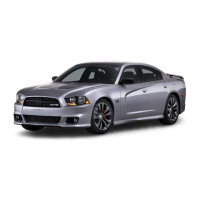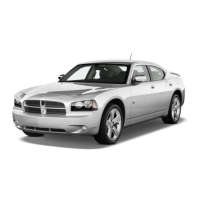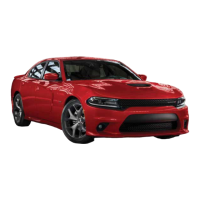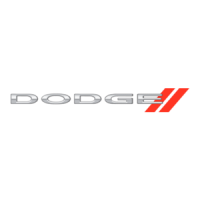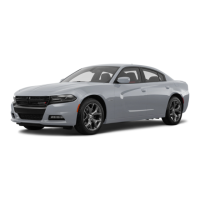Do you have a question about the Dodge charger 2013 and is the answer not in the manual?
Congratulations on selecting your new Chrysler Group LLC vehicle. Be assured that it represents precision workmanship, distinctive styling, and high quality - all essentials that are traditional to our vehicles.
Consult the Table of Contents to determine which section contains the information you desire. The detailed index at the back of this Owner’s Manual contains a complete listing of all subjects.
This Owners Manual contains WARNINGS against operating procedures that could result in a collision or bodily injury. It also contains CAUTIONS against procedures that could result in damage to your vehicle.
The Vehicle Identification Number (VIN) is on the left front corner of the instrument panel. The VIN is visible from outside of the vehicle through the windshield.
Any modifications or alterations to this vehicle could seriously affect its roadworthiness and safety and may lead to a collision resulting in serious injury or death.
Your vehicle uses a keyless ignition system consisting of a Key Fob with Remote Keyless Entry (RKE) transmitter and a Keyless Ignition Node (KIN).
Covers manual and power door locks, and the child-protection door lock system for rear doors.
Details on the vehicle's restraint systems including lap/shoulder belts, air bags, and child restraint considerations.
Provides guidance on transporting passengers, exhaust gas safety, and general vehicle safety checks.
Details on inside day/night mirror, automatic dimming mirror, outside mirrors, folding features, approach lights, and tilt mirrors in reverse.
Explains the Blind Spot Monitoring (BSM) system using radar sensors to detect vehicles in blind spot zones.
Describes the voice-activated, hands-free, in-vehicle communication system and its features.
Explains how to use voice commands to control AM/FM radio, satellite radio, disc player, SD Card, USB/iPod, and Sirius Travel Link.
Covers power seats, power lumbar, heated seats, ventilated seats, manual seats, and head restraints.
Diagram and list of features located on the instrument panel, including air outlets, Uconnect® system, and hazard switch.
Detailed descriptions of instrument cluster gauges and indicators like tachometer, AWD indicator, and turn signals.
Explains the driver-interactive display in the instrument cluster, its sections, and types of messages displayed.
Lists reconfigurable amber caution telltales, including Forward Collision Warning (FCW) OFF status and system warnings.
Covers normal starting, extreme cold weather starting, and procedures for when the engine fails to start.
Details on transmission operation, including shift interlock, gear ranges, and specific transmission types like 8-speed and 5-speed.
Guidance on acceleration, traction, and general precautions for driving on wet, icy, or snow-covered roads.
Information on ABS, TCS, BAS, ESC, HSA, Ready Alert Braking, and Rain Brake Support systems.
Detailed steps and warnings for safely jacking the vehicle and changing a flat tire.
Step-by-step guide for safely jump-starting a discharged battery using jumper cables or a booster pack.
Guidance on how to free the vehicle using a rocking motion if it becomes stuck in mud, sand, or snow.
Procedures for towing a disabled vehicle using a commercial wrecker service, including RWD and AWD models.
Identifies components in the engine compartment for the 3.6L engine, including fuses, oil dipstick, and coolant reservoir.
Explains the OBD II system, its monitoring functions for emissions and engine control, and the Malfunction Indicator Light (MIL).
Recommends using genuine MOPAR® parts for maintenance and repairs to ensure designed performance and warranty coverage.
Details required maintenance services determined by engineers, covering engine oil, filters, and other components.
Provides information on the automatic oil change indicator system and how it reminds you for scheduled maintenance.
A chart detailing required maintenance services based on mileage or time passed, including additional inspections and replacements.
Tips on preparing for appointments, making a list of issues, and being reasonable with requests to service advisors.
Information on contacting Chrysler Group LLC Customer Center, Chrysler Canada Inc., and assistance for hearing or speech impaired customers.
Guidance on informing the National Highway Traffic Safety Administration (NHTSA) about potential vehicle safety defects.
Congratulations on selecting your new Chrysler Group LLC vehicle. Be assured that it represents precision workmanship, distinctive styling, and high quality - all essentials that are traditional to our vehicles.
Consult the Table of Contents to determine which section contains the information you desire. The detailed index at the back of this Owner’s Manual contains a complete listing of all subjects.
This Owners Manual contains WARNINGS against operating procedures that could result in a collision or bodily injury. It also contains CAUTIONS against procedures that could result in damage to your vehicle.
The Vehicle Identification Number (VIN) is on the left front corner of the instrument panel. The VIN is visible from outside of the vehicle through the windshield.
Any modifications or alterations to this vehicle could seriously affect its roadworthiness and safety and may lead to a collision resulting in serious injury or death.
Your vehicle uses a keyless ignition system consisting of a Key Fob with Remote Keyless Entry (RKE) transmitter and a Keyless Ignition Node (KIN).
Covers manual and power door locks, and the child-protection door lock system for rear doors.
Details on the vehicle's restraint systems including lap/shoulder belts, air bags, and child restraint considerations.
Provides guidance on transporting passengers, exhaust gas safety, and general vehicle safety checks.
Details on inside day/night mirror, automatic dimming mirror, outside mirrors, folding features, approach lights, and tilt mirrors in reverse.
Explains the Blind Spot Monitoring (BSM) system using radar sensors to detect vehicles in blind spot zones.
Describes the voice-activated, hands-free, in-vehicle communication system and its features.
Explains how to use voice commands to control AM/FM radio, satellite radio, disc player, SD Card, USB/iPod, and Sirius Travel Link.
Covers power seats, power lumbar, heated seats, ventilated seats, manual seats, and head restraints.
Diagram and list of features located on the instrument panel, including air outlets, Uconnect® system, and hazard switch.
Detailed descriptions of instrument cluster gauges and indicators like tachometer, AWD indicator, and turn signals.
Explains the driver-interactive display in the instrument cluster, its sections, and types of messages displayed.
Lists reconfigurable amber caution telltales, including Forward Collision Warning (FCW) OFF status and system warnings.
Covers normal starting, extreme cold weather starting, and procedures for when the engine fails to start.
Details on transmission operation, including shift interlock, gear ranges, and specific transmission types like 8-speed and 5-speed.
Guidance on acceleration, traction, and general precautions for driving on wet, icy, or snow-covered roads.
Information on ABS, TCS, BAS, ESC, HSA, Ready Alert Braking, and Rain Brake Support systems.
Detailed steps and warnings for safely jacking the vehicle and changing a flat tire.
Step-by-step guide for safely jump-starting a discharged battery using jumper cables or a booster pack.
Guidance on how to free the vehicle using a rocking motion if it becomes stuck in mud, sand, or snow.
Procedures for towing a disabled vehicle using a commercial wrecker service, including RWD and AWD models.
Identifies components in the engine compartment for the 3.6L engine, including fuses, oil dipstick, and coolant reservoir.
Explains the OBD II system, its monitoring functions for emissions and engine control, and the Malfunction Indicator Light (MIL).
Recommends using genuine MOPAR® parts for maintenance and repairs to ensure designed performance and warranty coverage.
Details required maintenance services determined by engineers, covering engine oil, filters, and other components.
Provides information on the automatic oil change indicator system and how it reminds you for scheduled maintenance.
A chart detailing required maintenance services based on mileage or time passed, including additional inspections and replacements.
Tips on preparing for appointments, making a list of issues, and being reasonable with requests to service advisors.
Information on contacting Chrysler Group LLC Customer Center, Chrysler Canada Inc., and assistance for hearing or speech impaired customers.
Guidance on informing the National Highway Traffic Safety Administration (NHTSA) about potential vehicle safety defects.
| Brand | Dodge |
|---|---|
| Model | charger 2013 |
| Category | Automobile |
| Language | English |
